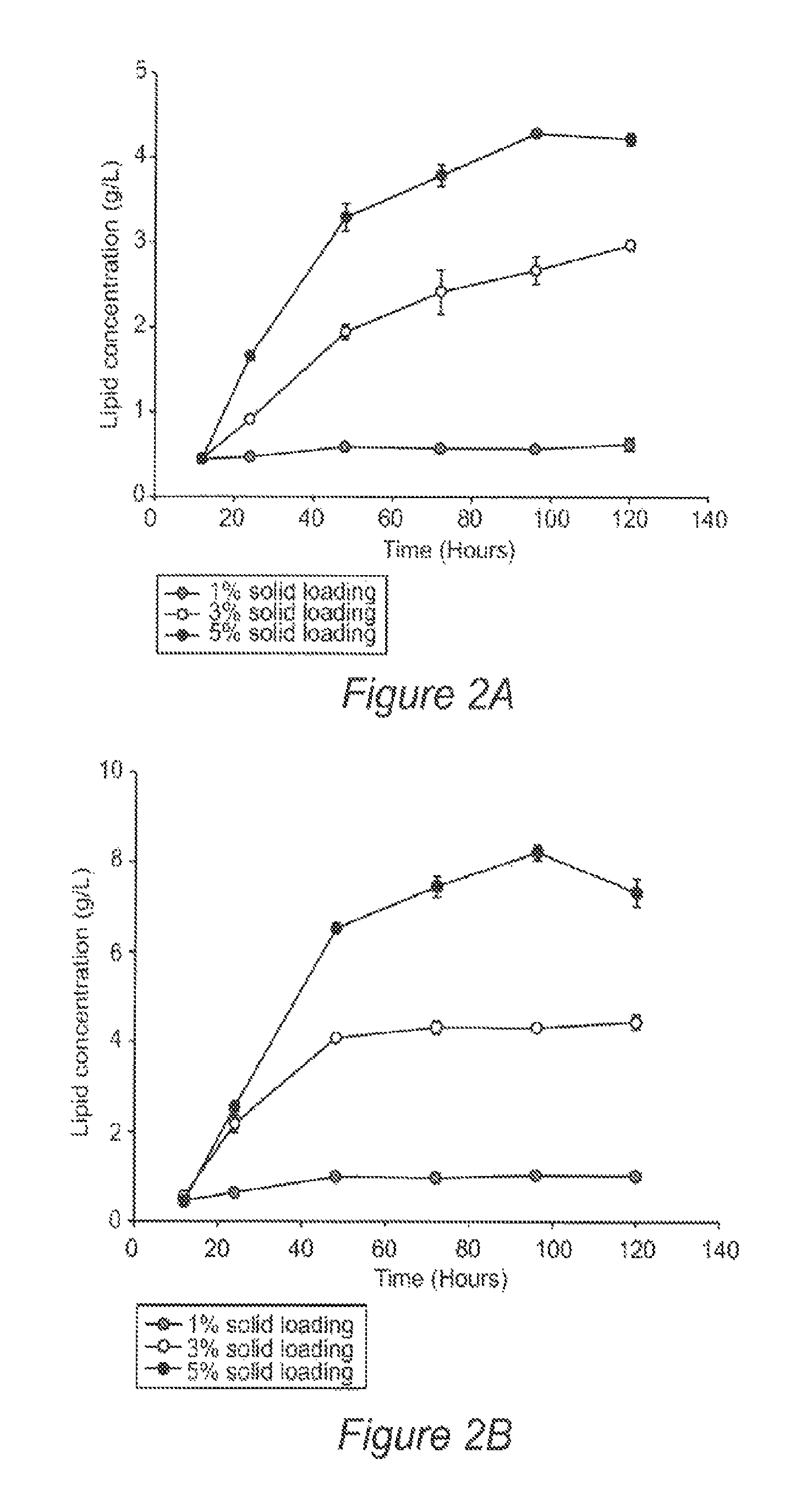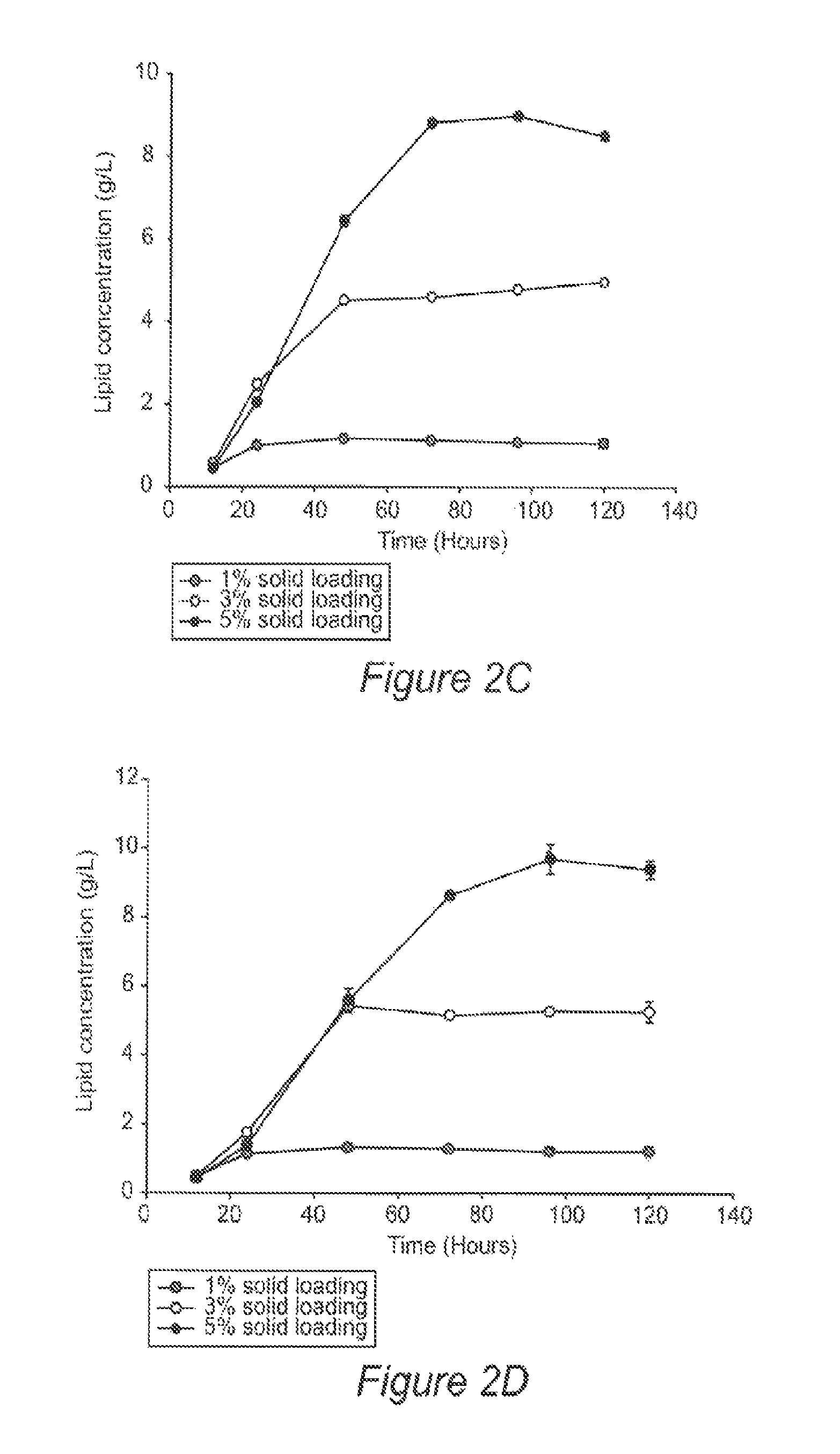Simultaneous saccharification and fermentation(SSF) of lignocellulosic biomass for single cell oil production by oleaginous microorganisms
a technology of lignocellulosic biomass and lignocellulosic biomass, which is applied in the field of methods and systems for lipid production by oleaginous fungi and yeasts, can solve the problems of limited availability of feasible technical routes that allow for the near-term production of such fuel, and lack of sustainable sugar supply
- Summary
- Abstract
- Description
- Claims
- Application Information
AI Technical Summary
Benefits of technology
Problems solved by technology
Method used
Image
Examples
example 1
Simultaneous Saccharification and Fermentation of Avicel Cellulose by Oleaginous Fungus for Microbial Oil Production
[0046]The filamentous fungus Mortierella isabellina was selected for single cell oil production by simultaneous saccharification and fermentation (SSF) process. The enzyme mixture of cellulases from Novozyme was prepared in phosphate buffer with pH 5.0 and sterilized by passing through 0.20 μm membrane filters (Millipore, MA). All SSF experiments were conducted in 250 mL flasks with three solid loading levels 1%, 3% and 5% (w / v) and four cellulase loading levels 5, 15, 30, 60 FPU / g cellulose. The cultures were maintained at 28° C. and 180 rpm.
[0047]FIG. 2 presents lipid concentrations in the media versus time during SSF with the cellulase loadings at 5 FPU / g (A), 15 FPU / g (B) 30 FPU / g (C), 60 FPU / g (D) respectively. The results clearly supported that cellulose loading was the limitation factor for microbial oil's accumulation in this study. Lipid production constantly ...
example 2
Simultaneous Saccharification and Fermentation of Avicel Cellulose by Oleaginous Yeast for Microbial Oil Production
[0048]The oleaginous yeast Cryptococcus curvatus was applied in SSF process by using Avicel cellulose for microbial oil production. The media preparations and culture conditions were the same as those for the fungus in Example 1. FIG. 3 shows lipid concentrations in the media versus time during SSF with the solid loadings at 1% (A), 3% (B) and 5% (C) respectively. At 1% (w / v) solid loading, the lipid concentrations increased with the cellulase loadings and lipid concentrations reached highest with the cellulase loading at 60 FPU / g cellulose. At 3% (w / v) solid loading, the lipid concentrations were comparable at the cellulase loadings between 30 and 60 FPU / g cellulose. While at 5% (w / v) solid loading, the optimal cellulase loadings in terms of lipid concentrations were 15 and 30 FPU / g cellulose. The results indicated that the solid loadings and cellulase supplement had a...
example 3
Co-Utilization of Glucose and Xylose by Cryptococcus Curvatus
[0049]During the simultaneous saccharification and fermentation of biomass pretreated by Type B pretreatment technologies, both pentose and hexoses from the biomass will be hydrolyzed and saccharified for lipid production. Therefore, in this work, co-fermentation of glucose and xylose was studied by C. curvatus to investigate the potential fermentability of the Type B pretreated biomass during the SSF process.
[0050]FIG. 4A-G shows the sugar consumption by C. curvatus with different glucose-to-xylose ratios. Generally xylose consumption started once glucose was depleted in the media, while at glucose / xylose ratio of 1:1, xylose was taken up with glucose simultaneously although the uptake rate was much lower than that of glucose. However, among all the culture conditions, the total sugar consumption rates were almost the same. Table 1 presents the biomass, lipid contents and glucose and xylose consumption rates in each cult...
PUM
| Property | Measurement | Unit |
|---|---|---|
| temperature | aaaaa | aaaaa |
| concentration | aaaaa | aaaaa |
| temperature | aaaaa | aaaaa |
Abstract
Description
Claims
Application Information
 Login to View More
Login to View More - R&D
- Intellectual Property
- Life Sciences
- Materials
- Tech Scout
- Unparalleled Data Quality
- Higher Quality Content
- 60% Fewer Hallucinations
Browse by: Latest US Patents, China's latest patents, Technical Efficacy Thesaurus, Application Domain, Technology Topic, Popular Technical Reports.
© 2025 PatSnap. All rights reserved.Legal|Privacy policy|Modern Slavery Act Transparency Statement|Sitemap|About US| Contact US: help@patsnap.com



